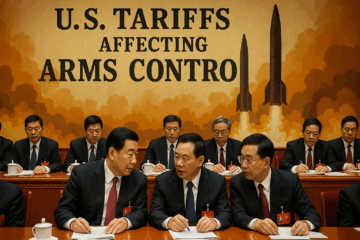Cyberspace is the new battleground for nations vying for global dominance. At the heart of this competition lies the semiconductor industry—a linchpin of modern technology. It is essential for computing, artificial intelligence (AI), and advanced military systems. Understanding the dynamics of semiconductor production and supply chains provides critical insights into how cyber deterrence strategies are formulated and executed.
Semiconductors: The Backbone of Cyber Power
Semiconductors enable the computing power that drives everything from commercial applications to military operations. Advanced chips are critical for AI, autonomous systems, and national security infrastructure. As nations race to secure technological dominance, control over semiconductor production becomes a central element of cyber deterrence.
The production of semiconductors is extraordinarily complex and relies on a global supply chain. No single country is self-sufficient in this domain. Manufacturing processes demand rare metals, precision tools, and expertise spanning Japan, the Netherlands, South Korea, Taiwan, and the United States. Companies like TSMC (Taiwan), Intel (United States), and Samsung (South Korea) dominate the field, with TSMC leading in advanced chip production. Advanced Semiconductor Materials Lithography (ASML), a Dutch company, monopolizes the production of extreme ultraviolet (EUV) lithography machines, critical for fabricating cutting-edge chips.
The Strategic Importance of Semiconductors
Semiconductors are more than just a commercial product—they are a strategic resource that nations leverage to project power in cyberspace. The United States has long recognized the importance of staying ahead in chip technology, aiming to maintain at least a two-generation lead over adversaries like China. This lead is not just about technological superiority but is also about cyber deterrence.
Cyber deterrence relies on the ability to defend, retaliate, or disrupt an adversary’s cyber capabilities. Advanced semiconductors provide the computational power necessary for AI-driven cybersecurity systems, intelligence gathering, and offensive cyber operations. For example, autonomous systems in modern warfare require sophisticated chips to function effectively. If a nation lacks access to such technology, its cyber capabilities are significantly weakened.
China’s Vulnerability and Response
China, despite being the second-largest economy and a global manufacturing powerhouse, has a surprising weakness in the semiconductor supply chain. It spends more on importing chips than oil and relies heavily on foreign suppliers, including its geopolitical rivals. This dependency creates a critical vulnerability in its cyber and AI ambitions.
Recognizing this weakness, China launched massive initiatives to achieve self-sufficiency in semiconductor production. However, the barriers to entry are steep. Manufacturing cutting-edge chips requires material purity at a level of 99.99999 percent, and even a minor defect can render a chip unusable. The complexity of the global supply chain further complicates China’s efforts. For instance, ASML’s EUV lithography machines, essential for advanced chip production, are legally restricted from being sold to China under export control agreements led by the United States.
China’s strategy focuses on targeting chokepoints in the supply chain while ramping up domestic production of less advanced chips. Success in this endeavor would significantly alter the balance of power in cyberspace, enabling China to compete more effectively in AI and cyber operations. However, for now, its reliance on foreign technology remains a significant deterrent.
US Strategy: Strengthening Deterrence Through Dominance
The United States took proactive steps to secure its dominance in semiconductor technology as part of its cyber deterrence strategy. Legislation like the 2022 CHIPS and Science Act provides billions in subsidies to bolster domestic chip production. The US also works to integrate government, industry, and academia to address challenges in manpower, education, and research and development.
The American approach to cyber deterrence is twofold. First, it seeks to maintain its technological edge by investing in leading-edge chips while ensuring a robust supply of legacy nodes for essential systems. Second, it actively restricts access to critical technologies for adversaries. For instance, since 2018, the export of EUV lithography machines to China has been prohibited, a move aimed at stalling China’s progress in advanced semiconductor manufacturing.
This strategy aligns with the broader geopolitical framework, where supply chain control becomes a tool for exerting influence. By leveraging its dominance in semiconductors, the US can deny adversaries the tools they need to compete in AI-driven cyber capabilities, thereby strengthening its cyber deterrence posture.
The Role of AI and Advanced Chips in Cyber Deterrence
AI is a cornerstone of cyber operations, from defensive systems that identify and mitigate threats to offensive tools that exploit vulnerabilities in adversarial networks. The power of AI is directly tied to the availability of advanced chips, which enable greater computational efficiency and data processing.
In the AI arms race, semiconductors are the critical enabler. Nations with access to advanced chips can train larger models, process more data, and deploy more sophisticated algorithms. Conversely, those lacking access are at a significant disadvantage. This dynamic emphasizes the importance of securing semiconductor supply chains as part of national cyber deterrence strategies.
Geopolitics and the Future of Cyber Deterrence
The geopolitical implications of semiconductor dominance extend beyond cyber operations. Control over the chip supply chain influences alliances, trade policies, and even the balance of power in global governance. Governments increasingly push nations and companies to choose sides, creating a polarized landscape.
The US and its allies currently hold a strong position, but the race is far from over. As China invests heavily in self-sufficiency, the stakes in the semiconductor arms race continue to rise. The future of cyber deterrence will depend on the ability of nations to secure their supply chains, innovate in chip technology, and adapt to the rapidly evolving landscape of AI and cybersecurity.
Conclusion
Semiconductors are not just a technological marvel—they are a strategic weapon in the cyber domain. As nations compete for supremacy, control over chip production and supply chains will play a pivotal role in shaping cyber deterrence strategies. The US, with its technological edge and integrated approach, aims to maintain its dominance, while China’s efforts to overcome its vulnerabilities will redefine the global order. In this high-stakes competition, the invisible hand of the market is guided by the visible hand of governments, ensuring that semiconductors remain at the heart of cyber power.
Adam Harris, PhD, is a career cyber professional who both practices the profession and teaches at the university level. The views expressed are his own.




